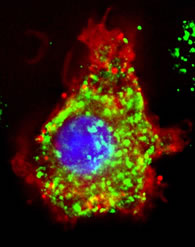For years, doctors and other health professionals have been telling us that too much stress can kill us.
Well, it’s true.
Increasing research is showing that stress in the body changes how cells, systems, and organs function. Too much stress in our bodies can lead to increased cell death and many different kinds of diseases.
What kind of stress are we talking about?
Free radicals are chemicals that contain oxygen and are unstable, highly reactive substances. When the body uses and breaks down oxygen from its environment, free radicals are formed. These molecules are important for many cellular processes. But when levels of free radicals rise past a point, the excess amounts can have harmful, stress-producing effects on the body. This is called oxidative stress—stress at the cellular level that changes physiological functioning.
This can seem like an apparent contradiction: too much oxygen (obviously necessary for life!) can be toxic? However, it is a natural by-product of respiration and metabolism. Regular oxygen intake, as well as increased levels from exercising, must be metabolized by the body, which results in the formation of free radicals. We also encounter oxidative stress in the environment from heat, UV radiation, pollution, and a host of other chemicals we encounter frequently. These sources of free radicals alter physical functioning, contributing to many diseases.
The effects of oxidative stress
The map kinase (MAPK) pathway in the body is a series of biochemical reactions that are vitally important for many physical processes, including metabolism, growth, the production of new cells, and the disposal of old, damaged cells. This critical pathway has been the subject of our class readings and discussions this week as we have investigated how the MAPK pathway is involved in diseases like Alzheimer’s, Parkinson’s, Lou Gehrig’s (ALS), and the big killer, cancer. Something all these diseases seem to have in common is oxidative stress as a factor negatively affecting the function of the MAPK pathway.
How exactly does oxidative stress alter this important biological pathway? Stress can overactivate microglia, cells in the brain responsible for repairing damage. If there is too much microglia activity, they “clean up” tissue a little too much, killing and removing more cells than is necessary. This may be what is going on in Alzheimer’s Disease, a degenerative disease characterized by loss of brain tissue.

Microglia (green) busy at work!
Oxidative stress can also change the states of genes that code for important proteins and factors, including a family of proteins called ubiquitins that break down and recycle old proteins. If these proteins aren’t functioning correctly, other kinds of proteins can build up into significant deposits in tissue, leading to impaired function. This is evident in both Alzheimer’s and Parkinson’s Disease, both of which show pathological amounts of proteins building up in the brain.

Plaques (orange circles) caused by protein deposits in the Alzheimer’s brain
SOD1 is an enzyme that converts harmful free radicals into less dangerous substances. However, it can be de-activated by too much oxidative stress, allowing free radicals to build up and areas of the body to become inflammed. In both Lou Gehrig’s Disease and Parkinson’s Disease, inflammation of the nerve cells may contribute to the loss of neurons, a primary characteristic of these diseases.
Dopamine neurons, lost in Parkinson’s Disease, are critically important for movement abilities
Finally, the MAPK pathway is necessary for controlling the cycle of cell death and growth, which allows for new cells to replace old ones. However, in cases like cancer, if this pathway is harmed, cells can multiply rapidly, forming tumors. In other cases, cells die too quickly and are not replaced right away. Disrupting this pathway through oxidative stress can have a severe effect on the body.
How is oxidative stress combated?
Antioxidants! These molecules can come from a variety of sources and effectively neutralize free radicals in the body. By breaking down free radicals, they have the potential to stop the damage of oxidative stress. Research studies are currently investigating how antioxidants can protect the body from damage as well as help treat diseases like Alzheimer’s and Parkinson’s.
Some kinds of berries, like blueberries, contain high levels of antioxidants
Some sources of antioxidants include vitamins C, E, A, and polyphenols, to name a few. These are commonly found in many fruits, dark green or yellow vegetables, oils, tea, and wine. Other natural antioxidants like melatonin and ubiquitol are produced in the body already. As the value of these substances continues to be demonstrated by scientific research, they may become a useful nutritional therapy for degenerative diseases like Alzheimer’s, Parkinson’s, Lou Gehrig’s, and cancer.